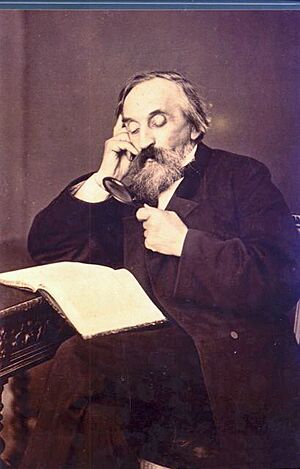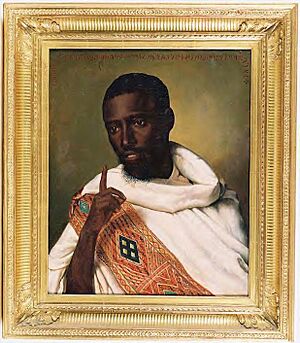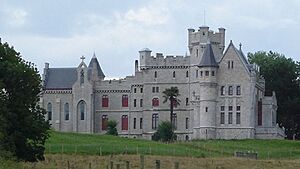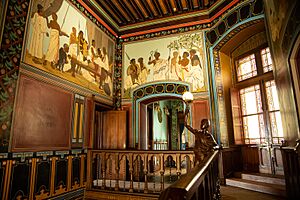Antoine Thomson d'Abbadie facts for kids
Quick facts for kids
Antoine Thomson d'Abbadie
|
|
|---|---|

Antoine Thomson d'Abbadie
|
|
| Born | 3 January 1810 |
| Died | 19 March 1897 (aged 87) Paris, France
|
| Nationality | Irish, French, Basque |
| Citizenship | France |
| Scientific career | |
| Fields | Geographer |
Antoine Thomson d'Abbadie d'Arrast (born January 3, 1810 – died March 19, 1897) was an amazing explorer and scientist. He was born in Ireland but was also French. Antoine was a geographer, someone who studies the Earth's surface. He was also an ethnologist, studying different cultures, a linguist, studying languages, and an astronomer, studying stars. He is famous for his trips to Ethiopia in the 1800s. He traveled with his younger brother, Arnaud-Michel d'Abbadie.
Contents
About Antoine d'Abbadie
Antoine was born in Dublin, Ireland. His family was partly Basque, from a region in France called Soule. His mother was Irish, and his father was French. His family moved to France in 1818. There, Antoine and his brother received a great science education.
In 1827, Antoine earned a bachelor's degree in Toulouse. He then studied law in Paris starting in 1829. Later in life, he married Virginie Vincent de Saint-Bonnet in 1859. They settled in Hendaye, where he bought a lot of land. He built a castle there and even became the mayor of the city from 1871 to 1875.
Antoine d'Abbadie was a very respected person. He received the Legion of Honour, a special award in France. He also became the president of the French Academy of Sciences. When he died in 1897, he left his castle and land to the Academy of Sciences. He had one condition: they had to create a huge catalog of half a million stars within 50 years.
Antoine's Early Life and Learning
Antoine's family moved to France around 1820. They lived in Toulouse, and his parents made sure their children had a good education at home. Antoine said he was raised in the "English tradition." He learned a lot from his governess. He was a very curious child. He once asked, "What lies at the end of the road?" When told "A river," he asked, "And what lies beyond the river?" Then, "What lies beyond the mountain?" When his governess said she didn't know, Antoine declared, "Then I shall journey forth and discover it myself!"
This strong desire to learn and explore stayed with him his whole life. He was also very good at learning languages. He could speak English, Italian, German, Latin, Greek, Hebrew, Arabic, Berber, and several Ethiopian languages.
In 1827, he finished his high school studies. He then went to Toulouse to study law. Even then, he had a secret, exciting plan. He wanted to explore the inside of Africa. He was inspired by books about travels in East Africa. He believed that studying other people was the most important thing a person could do.
Preparing for Adventure
Antoine spent six years getting ready for his big adventure. He was already very agile, even for someone from the Basque country. He trained himself with many physical exercises. He wanted to be ready for the hard work and challenges explorers face. He learned fencing, practiced gymnastics, and ran long distances in different weather. He was also an excellent swimmer. Once, he amazed people by swimming almost 500 meters out to a rock in the ocean.
Science and Journeys
In 1835, the French Academy sent Antoine on a science trip to Brazil. He published his findings later in a book. In November 1836, he sailed on a ship called L'Andromède. On this trip, he met Louis-Napoléon Bonaparte, who later became the President of France. Antoine, who knew a fortune teller, liked to make predictions. He told the prince, "You will rule France!" Years later, when the prince became president, Antoine joked that they were supposed to meet at the Tuileries Palace, not the Élysée Palace. The prince replied, "The Élysée is not far from the Tuileries!"
After his Brazil mission, Antoine quickly went to Cairo in 1837. There, he met his younger brother, Arnaud. The two young brothers, Antoine (26) and Arnaud (21), were about to spend almost 12 years in Ethiopia.
Exploring Ethiopia
The d'Abbadie brothers arrived in Massawa, Ethiopia, in February 1838. They traveled all over Ethiopia, going as far south as the Kingdom of Kaffa. Sometimes they traveled together, and sometimes they explored separately. Antoine didn't just do science. He also got involved in politics, helping France and Catholic missionaries.
Arnaud became a general, judge, and diplomat. He even fought in battles and earned the title of Ras, which was a very important title in Ethiopia. Antoine, on the other hand, focused on learning. He became a scholar and a teacher. He said that when you are in a foreign country, it's good to have a job that fits local customs. Otherwise, people might think you are a spy. Since he couldn't fight or trade, he became a "mamhir," or teacher and scholar. He learned a lot from Ethiopian schools.
For a long time, the two brothers lived like the local people. They stopped wearing European clothes and wore turbans and togas. They even walked barefoot, as only certain people wore sandals back then. Because they fit in so well, they were welcomed wherever they went.
The d'Abbadie brothers traveled a lot in Ethiopia. They wrote down everything they saw and learned. This included information about people, places, religion, laws, cultures, languages, and history. Antoine also collected 250 old handwritten books. With the help of an Ethiopian scholar named Debtera Tewelde Medhin of Welkait, Antoine created the first ever Amharic-French dictionary. It had 15,000 words!
In late 1848, the brothers left Ethiopia. They had completed their ambitious exploration goals and even more.
Antoine's Discoveries and Inventions
Antoine faced some disagreements about his findings, especially about his geography. Some people, like Charles Tilstone Beke, doubted his stories. But over time, other explorers proved that Antoine was very reliable. He was right about his facts, even though he was wrong about the Blue Nile being the main river.
He published his maps and findings about Ethiopia between 1860 and 1873. These books had very useful information and maps. He also wrote about the 234 Ethiopian manuscripts he collected. Antoine created many dictionaries, including a large dictionary for the Amharic language in 1881. He also wrote many papers about Ethiopia's geography, coins, and old writings.
Antoine also helped improve techniques for geodesy, which is the science of measuring the Earth's shape and size. He even invented a new tool called a theodolite for measuring angles.
Antoine and the Basque Culture
Antoine's father was Basque, and Antoine became very interested in the Basque Language. This happened after he met Prince Louis Lucien Bonaparte in London. He started studying the Basque language in 1852.
Antoine spoke two different Basque dialects and lived in a Basque region. He considered himself a Basque person from Soule. He is also known for popularizing the saying Zazpiak Bat, which means "The Seven (Basque regions) are One." He promoted this idea at Basque festivals.
Abbadia Castle
Antoine d'Abbadie named his castle home Abbadia. This is the name still used in Basque. In French, it's often called Chateau d'Abbadie or Domaine d'Abbadia. Locally, people sometimes call it "Antoine d'Abbadie's Castle."
The castle was built between 1864 and 1879 on a cliff overlooking the Atlantic Ocean. It was designed by a famous architect named Eugène Viollet-le-Duc. The castle is in the Neo Gothic style, which means it looks like old Gothic castles. It's considered a very important example of this style in France.
The castle has three main parts:
- An observatory and library, where Antoine studied stars and kept his books.
- A chapel, for religious services.
- Living quarters, where he lived.
Above the main entrance door, there's an Irish Gaelic phrase carved: "Céd míle fáilte." This means "one hundred thousand welcomes" and honors his Irish background.
The castle still belongs to the Academy of Science. Antoine gave it to them in 1895. He asked them to create a catalog of half a million stars within 50 years. He wanted members of religious orders to do this work.
The French government recognized the castle as a protected historical monument in 1984. Most of the castle's land is now owned by the Coastal Protection Agency. The city of Hendaye helps manage it.
Images for kids










